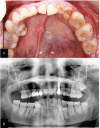Placing Dental Implants through Impacted Teeth to Support a Fixed Partial Denture in a Geriatric Patient as an Alternative to Invasive Extraction Surgeries
- PMID: 32906166
- PMCID: PMC7536093
- DOI: 10.1055/s-0040-1716318
Placing Dental Implants through Impacted Teeth to Support a Fixed Partial Denture in a Geriatric Patient as an Alternative to Invasive Extraction Surgeries
Abstract
Multiple dental impactions not associated with craniofacial syndromes are a rare condition and present the dentist with a therapeutic challenge when it comes to performing surgical/restorative treatments in adult patients. This case report describes a geriatric patient with multiple impacted teeth restored by means of two different protocols. In the second quadrant, an impacted tooth was extracted followed by regeneration and placement of an implant. In the third quadrant, implants were placed though impacted teeth for restoration with a fixed partial prosthesis. Placing dental implants through impacted teeth may offer a possible therapeutic option for implant-supported restorations in middle-aged or elderly patients, for whom surgery and orthodontic traction are not possible, and/or patients who refuse to undergo more invasive extraction surgery.
Conflict of interest statement
None declared.
Figures







Similar articles
-
Inappropriate Protocol of Implant Placement in Contact with Impacted Teeth Leading to Failure.Case Rep Dent. 2023 Jun 20;2023:7328891. doi: 10.1155/2023/7328891. eCollection 2023. Case Rep Dent. 2023. PMID: 37384258 Free PMC article.
-
Extraction of Maxillary Impacted Teeth with Simultaneous Immediate Full Mouth Loading Using Long Implant: A Case Report.Bull Tokyo Dent Coll. 2020 Jul 4;61(2):135-143. doi: 10.2209/tdcpublication.2019-0004. Epub 2020 Jun 5. Bull Tokyo Dent Coll. 2020. PMID: 32507778
-
Immediate implants after the removal of maxillary impacted canines: a clinical series of nine patients.Int J Oral Maxillofac Implants. 2009 Mar-Apr;24(2):348-52. Int J Oral Maxillofac Implants. 2009. PMID: 19492652 Clinical Trial.
-
Should we extract teeth to avoid tooth-implant combinations?J Oral Rehabil. 2008 Jan;35 Suppl 1:44-54. doi: 10.1111/j.1365-2842.2007.01828.x. J Oral Rehabil. 2008. PMID: 18181933 Review.
-
Early and immediately restored and loaded dental implants for single-tooth and partial-arch applications.Int J Oral Maxillofac Implants. 2004;19 Suppl:92-102. Int J Oral Maxillofac Implants. 2004. PMID: 15635949 Review.
Cited by
-
Inappropriate Protocol of Implant Placement in Contact with Impacted Teeth Leading to Failure.Case Rep Dent. 2023 Jun 20;2023:7328891. doi: 10.1155/2023/7328891. eCollection 2023. Case Rep Dent. 2023. PMID: 37384258 Free PMC article.
-
Decision-Making Criteria of Odontectomy or Surgical Exposure in Impacted Maxillary Canine Based on Treatment Difficulty Index Modification.Eur J Dent. 2022 Oct;16(4):796-802. doi: 10.1055/s-0041-1739447. Epub 2022 Jan 11. Eur J Dent. 2022. PMID: 35016233 Free PMC article.
-
Management of an infectious complication appearing in a transcanine implant: a case report.Int J Implant Dent. 2025 May 19;11(1):37. doi: 10.1186/s40729-025-00626-6. Int J Implant Dent. 2025. PMID: 40388046 Free PMC article.
References
-
- Becker A, Chaushu S. Success rate and duration of orthodontic treatment for adult patients with palatally impacted maxillary canines. Am J Orthod Dentofacial Orthop. 2003;124(05):509–514. - PubMed
-
- Mazor Z, Segal P, Levin L. Computer-guided implant placement for rehabilitation of the edentulous maxilla with two impacted canines: an approach without extraction of the impacted teeth. Int J Periodontics Restorative Dent. 2015;35(01):93–97. - PubMed
-
- García B, Boronat A, Larrazabal C, Peñarrocha M, Peñarrocha M. Immediate implants after the removal of maxillary impacted canines: a clinical series of nine patients. Int J Oral Maxillofac Implants. 2009;24(02):348–352. - PubMed
-
- Felice P, Barausse C, Stefanini M, Pistilli R, Zucchelli G. A minimally invasive approach using a 4-mm implant without extraction of impacted maxillary canine: four-year postloading results. Int J Periodontics Restorative Dent. 2017;37(06):819–824. - PubMed
-
- Schroeder A, van der Zypen E, Stich H, Sutter F. The reactions of bone, connective tissue, and epithelium to endosteal implants with titanium-sprayed surfaces. J Maxillofac Surg. 1981;9(01):15–25. - PubMed
LinkOut - more resources
Full Text Sources

